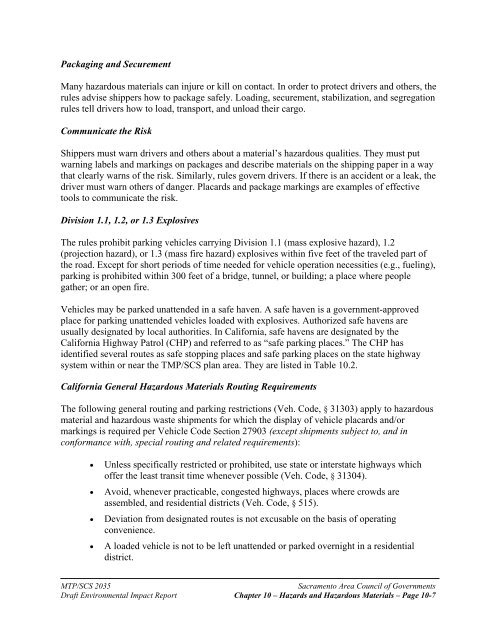CHAPTER 10 – HAZARDS AND HAZARDOUS MATERIALS - sacog
CHAPTER 10 – HAZARDS AND HAZARDOUS MATERIALS - sacog
CHAPTER 10 – HAZARDS AND HAZARDOUS MATERIALS - sacog
Create successful ePaper yourself
Turn your PDF publications into a flip-book with our unique Google optimized e-Paper software.
Packaging and Securement<br />
Many hazardous materials can injure or kill on contact. In order to protect drivers and others, the<br />
rules advise shippers how to package safely. Loading, securement, stabilization, and segregation<br />
rules tell drivers how to load, transport, and unload their cargo.<br />
Communicate the Risk<br />
Shippers must warn drivers and others about a material’s hazardous qualities. They must put<br />
warning labels and markings on packages and describe materials on the shipping paper in a way<br />
that clearly warns of the risk. Similarly, rules govern drivers. If there is an accident or a leak, the<br />
driver must warn others of danger. Placards and package markings are examples of effective<br />
tools to communicate the risk.<br />
Division 1.1, 1.2, or 1.3 Explosives<br />
The rules prohibit parking vehicles carrying Division 1.1 (mass explosive hazard), 1.2<br />
(projection hazard), or 1.3 (mass fire hazard) explosives within five feet of the traveled part of<br />
the road. Except for short periods of time needed for vehicle operation necessities (e.g., fueling),<br />
parking is prohibited within 300 feet of a bridge, tunnel, or building; a place where people<br />
gather; or an open fire.<br />
Vehicles may be parked unattended in a safe haven. A safe haven is a government-approved<br />
place for parking unattended vehicles loaded with explosives. Authorized safe havens are<br />
usually designated by local authorities. In California, safe havens are designated by the<br />
California Highway Patrol (CHP) and referred to as “safe parking places.” The CHP has<br />
identified several routes as safe stopping places and safe parking places on the state highway<br />
system within or near the TMP/SCS plan area. They are listed in Table <strong>10</strong>.2.<br />
California General Hazardous Materials Routing Requirements<br />
The following general routing and parking restrictions (Veh. Code, § 31303) apply to hazardous<br />
material and hazardous waste shipments for which the display of vehicle placards and/or<br />
markings is required per Vehicle Code Section 27903 (except shipments subject to, and in<br />
conformance with, special routing and related requirements):<br />
<br />
<br />
<br />
<br />
Unless specifically restricted or prohibited, use state or interstate highways which<br />
offer the least transit time whenever possible (Veh. Code, § 31304).<br />
Avoid, whenever practicable, congested highways, places where crowds are<br />
assembled, and residential districts (Veh. Code, § 515).<br />
Deviation from designated routes is not excusable on the basis of operating<br />
convenience.<br />
A loaded vehicle is not to be left unattended or parked overnight in a residential<br />
district.<br />
MTP/SCS 2035<br />
Sacramento Area Council of Governments<br />
Draft Environmental Impact Report Chapter <strong>10</strong> <strong>–</strong> Hazards and Hazardous Materials <strong>–</strong> Page <strong>10</strong>-7
















